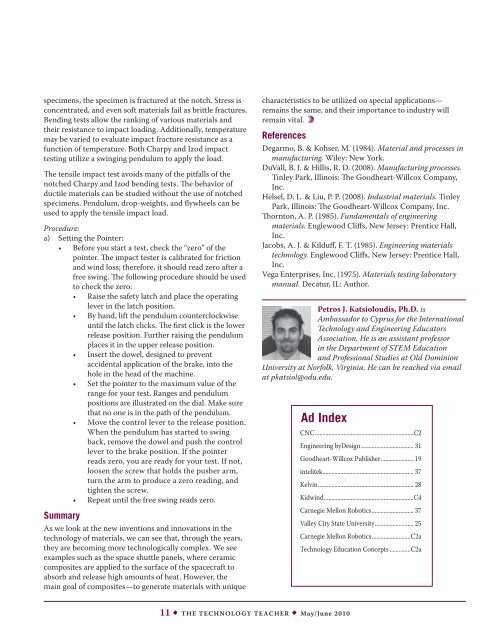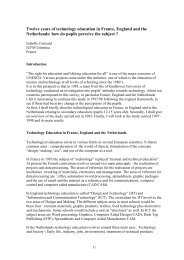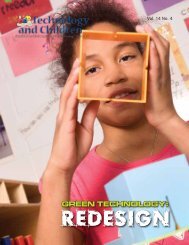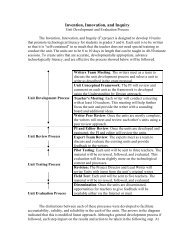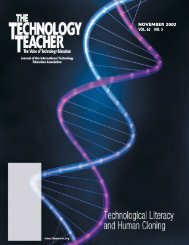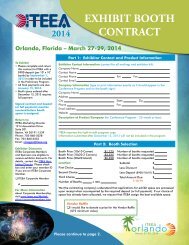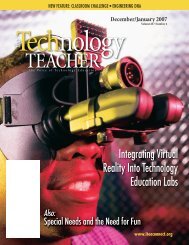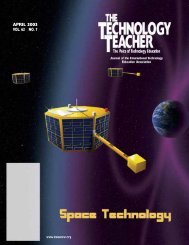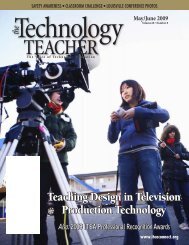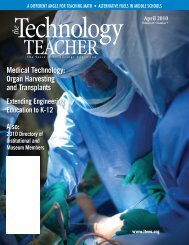May/June - Vol 69, No 8 - International Technology and Engineering ...
May/June - Vol 69, No 8 - International Technology and Engineering ...
May/June - Vol 69, No 8 - International Technology and Engineering ...
You also want an ePaper? Increase the reach of your titles
YUMPU automatically turns print PDFs into web optimized ePapers that Google loves.
specimens, the specimen is fractured at the notch. Stress is<br />
concentrated, <strong>and</strong> even soft materials fail as brittle fractures.<br />
Bending tests allow the ranking of various materials <strong>and</strong><br />
their resistance to impact loading. Additionally, temperature<br />
may be varied to evaluate impact fracture resistance as a<br />
function of temperature. Both Charpy <strong>and</strong> Izod impact<br />
testing utilize a swinging pendulum to apply the load.<br />
The tensile impact test avoids many of the pitfalls of the<br />
notched Charpy <strong>and</strong> Izod bending tests. The behavior of<br />
ductile materials can be studied without the use of notched<br />
specimens. Pendulum, drop-weights, <strong>and</strong> flywheels can be<br />
used to apply the tensile impact load.<br />
Procedure:<br />
a) Setting the Pointer:<br />
• Before you start a test, check the “zero” of the<br />
pointer. The impact tester is calibrated for friction<br />
<strong>and</strong> wind loss; therefore, it should read zero after a<br />
free swing. The following procedure should be used<br />
to check the zero:<br />
• Raise the safety latch <strong>and</strong> place the operating<br />
lever in the latch position.<br />
• By h<strong>and</strong>, lift the pendulum counterclockwise<br />
until the latch clicks. The first click is the lower<br />
release position. Further raising the pendulum<br />
places it in the upper release position.<br />
• Insert the dowel, designed to prevent<br />
accidental application of the brake, into the<br />
hole in the head of the machine.<br />
• Set the pointer to the maximum value of the<br />
range for your test. Ranges <strong>and</strong> pendulum<br />
positions are illustrated on the dial. Make sure<br />
that no one is in the path of the pendulum.<br />
• Move the control lever to the release position.<br />
When the pendulum has started to swing<br />
back, remove the dowel <strong>and</strong> push the control<br />
lever to the brake position. If the pointer<br />
reads zero, you are ready for your test. If not,<br />
loosen the screw that holds the pusher arm,<br />
turn the arm to produce a zero reading, <strong>and</strong><br />
tighten the screw.<br />
• Repeat until the free swing reads zero.<br />
Summary<br />
As we look at the new inventions <strong>and</strong> innovations in the<br />
technology of materials, we can see that, through the years,<br />
they are becoming more technologically complex. We see<br />
examples such as the space shuttle panels, where ceramic<br />
composites are applied to the surface of the spacecraft to<br />
absorb <strong>and</strong> release high amounts of heat. However, the<br />
main goal of composites—to generate materials with unique<br />
characteristics to be utilized on special applications—<br />
remains the same, <strong>and</strong> their importance to industry will<br />
remain vital.<br />
References<br />
Degarmo, B. & Kohser, M. (1984). Material <strong>and</strong> processes in<br />
manufacturing. Wiley: New York.<br />
DuVall, B. J. & Hillis, R. D. (2008). Manufacturing processes.<br />
Tinley Park, Illinois: The Goodheart-Willcox Company,<br />
Inc.<br />
Helsel, D. L. & Liu, P. P. (2008). Industrial materials. Tinley<br />
Park, Illinois: The Goodheart-Willcox Company, Inc.<br />
Thornton, A. P. (1985). Fundamentals of engineering<br />
materials. Englewood Cliffs, New Jersey: Prentice Hall,<br />
Inc.<br />
Jacobs, A. J. & Kilduff, F. T. (1985). <strong>Engineering</strong> materials<br />
technology. Englewood Cliffs, New Jersey: Prentice Hall,<br />
Inc.<br />
Vega Enterprises, Inc. (1975). Materials testing laboratory<br />
manual. Decatur, IL: Author.<br />
Petros J. Katsioloudis, Ph.D. is<br />
Ambassador to Cyprus for the <strong>International</strong><br />
<strong>Technology</strong> <strong>and</strong> <strong>Engineering</strong> Educators<br />
Association. He is an assistant professor<br />
in the Department of STEM Education<br />
<strong>and</strong> Professional Studies at Old Dominion<br />
University at <strong>No</strong>rfolk, Virginia. He can be reached via email<br />
at pkatsiol@odu.edu.<br />
Ad Index<br />
CNC...................................................................C2<br />
<strong>Engineering</strong> byDesign.................................... 31<br />
Goodheart-Willcox Publisher...................... 19<br />
intelitek............................................................. 37<br />
Kelvin................................................................ 28<br />
Kidwind............................................................C4<br />
Carnegie Mellon Robotics............................ 37<br />
Valley City State University.......................... 25<br />
Carnegie Mellon Robotics..........................C2a<br />
<strong>Technology</strong> Education Concepts...............C2a<br />
11 • The <strong>Technology</strong> Teacher • <strong>May</strong>/<strong>June</strong> 2010


